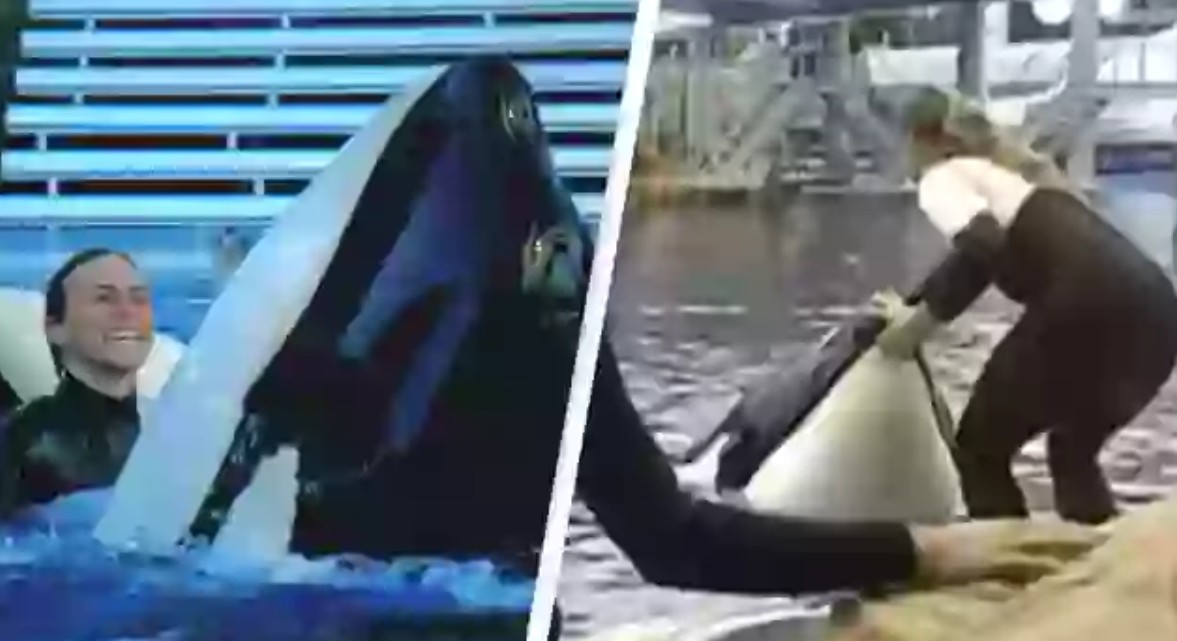The ocean’s apex predators are often admired from a safe distance, their sheer size and intelligence inspiring awe in marine enthusiasts. However, in early 2025, the world was confronted with a disturbing reminder of the risks involved when humans and wild animals interact up close. A viral video showing Jessica Radcliffe being attacked by an orca stunned social media users and sparked heated debates over animal captivity, safety protocols, and the ethics of marine entertainment.

The footage, raw and unsettling, spread rapidly across Twitter, TikTok, and Facebook. Within hours, hashtags related to the attack were trending globally. Many viewers were shocked not only by the suddenness of the incident but also by the fact that it occurred in what was assumed to be a controlled, professional environment.
Jessica Radcliffe and Full Video
Jessica Radcliffe, was an experienced marine life enthusiast with a professional background in aquatic animal care. Based in Australia, she had spent years working with various marine species in aquariums and research programs. Friends described her as passionate, fearless, and deeply committed to animal welfare.
Uncensored video causing public uproar about killer whale attack
jessica-radcliffe-orca-attack-video.mp4
At the time of the incident, Jessica was employed at a coastal marine park known for its orca performances and educational programs. Her role involved both behind-the-scenes animal care and on-stage presentations, which often included interactive demonstrations with the park’s star attraction a massive male orca named Kairos.
Her familiarity with Kairos made the attack all the more shocking. Jessica had reportedly worked with him for over two years and had never shown signs of fear or hesitation around him.
Setting and Circumstances Before the Attack
The incident took place during a mid-afternoon training session at the park’s main performance pool. According to eyewitnesses, it was a private rehearsal rather than a public show. The weather was mild, with calm water and no immediate environmental hazards.

Jessica, dressed in a black wetsuit, was standing near the edge of the pool while interacting with Kairos. She was performing a series of hand signals that the orca was trained to respond to, including flips, tail slaps, and close approaches. Several other trainers were nearby, and a camera crew was filming footage for an upcoming promotional video.
The Orca Involved
Kairos, a 5.5-ton, 25-foot-long male orca, had been in captivity since his early teens. Known for his striking black-and-white pattern and powerful presence, Kairos was considered a centerpiece attraction at the park.
While park officials insisted he had no record of aggressive incidents with trainers, marine life experts later pointed out that captive orcas often display unpredictable behavior due to the stress of confinement. Orcas in the wild can travel up to 100 miles a day a stark contrast to the limited space of an artificial tank.
Description of the Attack (as seen in the Video)
The viral video begins calmly, showing Jessica smiling as Kairos surfaces beside her. She strokes his rostrum (snout) and feeds him a small fish. For several seconds, the interaction appears routine.
Then, without warning, Kairos dives briefly before surging upward, grabbing Jessica by her arm in his powerful jaws. Gasps and screams are heard off-camera as the orca drags her into the water. The footage captures the chaotic moments that follow: Jessica struggling to surface, trainers frantically signaling to Kairos, and the water churning violently.
The most harrowing part of the video shows the orca pulling her underwater for several seconds at a time. At one point, Jessica’s hand briefly breaks the surface before disappearing again. The clip ends abruptly, leaving viewers uncertain of her fate.
Rescue Efforts and Aftermath
Park staff acted quickly, using emergency recall signals and throwing nets into the water to create a barrier between Jessica and Kairos. After what witnesses estimate was a 90-second struggle, the orca released her, allowing rescue divers to pull her to safety.
Jessica was rushed to a nearby hospital with severe lacerations, a dislocated shoulder, and signs of hypothermia. Doctors later confirmed she had survived, though her injuries required surgery and extensive rehabilitation.
In a brief statement from her hospital bed, Jessica thanked the rescue team and expressed her continued love for marine life, though she admitted the incident had been “the most terrifying moment” of her career.
Public and Media Response
Within hours of the footage appearing online, media outlets around the world picked up the story. Headlines ranged from sensational (“Killer Whale Nearly Kills Trainer on Camera”) to investigative (“Why Are Orcas Attacking Humans in Captivity?”).
On social media, reactions were mixed. Some viewers expressed sympathy for Jessica, praising her bravery and professionalism. Others focused on the orca’s behavior, arguing that captivity was to blame.
Animal rights groups such as PETA issued strong statements, calling for Kairos to be retired to a sea sanctuary. Meanwhile, supporters of marine parks emphasized that such incidents were rare and often preventable with better safety measures.
Expert Analysis
Marine biologists interviewed by major networks pointed to several possible triggers for the attack. Dr. Lena Moritz, a specialist in orca behavior, noted that even well-trained orcas are still wild animals with immense strength and unpredictable instincts.
“In captivity, these animals often exhibit stress behaviors that can escalate quickly,” Moritz explained. “Even something as simple as a misread hand signal or an unfamiliar scent can provoke an aggressive response.”
Former trainers also weighed in, drawing parallels to the infamous 2010 incident involving Dawn Brancheau and the orca Tilikum at SeaWorld Orlando. They stressed that while orcas are intelligent and trainable, they are never truly domesticated.
Broader Discussion: Orcas in Captivity
The Jessica Radcliffe incident reignited the long-standing debate about whether orcas should be kept in marine parks at all. Critics argue that confinement causes psychological distress, leading to aggression. Orcas in the wild live in complex social structures, hunt cooperatively, and cover vast distances none of which can be replicated in a tank.
Proponents of captivity argue that marine parks contribute to education and conservation, inspiring visitors to care about ocean ecosystems. However, high-profile incidents like this one have shifted public opinion toward sea sanctuaries and virtual reality alternatives to live shows.
Current Status and Lessons Learned
As of the latest updates, Jessica continues her recovery and is undergoing physical therapy. She has not yet confirmed whether she will return to hands-on orca work.
The marine park where the incident occurred temporarily suspended all orca performances and initiated a review of its safety protocols. Early reports suggest that new rules will include increased physical barriers between trainers and orcas during certain activities, as well as additional behavioral monitoring for each animal.
Jessica’s ordeal has also prompted a broader conversation about workplace safety for marine trainers and the emotional toll such incidents can have on both humans and animals.
The “Jessica Radcliffe orca attack video” serves as a sobering reminder that the ocean’s giants, no matter how familiar they seem in captivity, are still powerful predators. The footage has fueled global discussions about animal welfare, trainer safety, and the ethical boundaries of human–animal interaction.
For many, the incident underscores the need to respect the autonomy of wild creatures and to reconsider how society engages with them for entertainment. As Jessica herself said in her first public statement after the attack, “We must never forget that they are wild at heart and that is exactly what makes them so extraordinary.”
News –